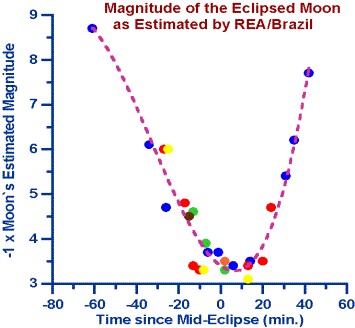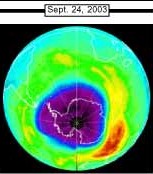Observed Brightness of the Moon during
the
Total Lunar Eclipse on Nov. 08-09 2003
By
Helio C. Vital

A
third-degree polynomial fit (r2= 0.937) to 27 REA`s observations made
using the reversed binoculars method yielded the following equation for the
Moon`s magnitude (m) around totality. Estimates from the following observers have been included: Alexandre Amorim (blue); Willian C. Souza (red);
Helio C. Vital (green); Felipe E. Hodar (yellow); Jose G. Aguiar (black) and Antonio Coelho (orange).
m = - (2.364x10-5
Dt3
+
2.327x10-3 Dt2
-
3.317x10-2 Dt + 3.40)
Dt being the
time interval in minutes since 01h18.5m UT.
The equation
has been used to generate the figures listed in the following table:
|
Nov.
09 (UT) |
Fitted Magnitude
|
Nov.
09 UT |
Fitted Magnitude
|
|
00h20m |
-8.5 |
01h19m |
-3.4 |
|
00h40m |
-6.7 |
01h20m |
-3.3 |
|
00h50m |
-5.6 |
01h21m |
-3.3 |
|
01h00m |
-4.6 |
01h22m |
-3.3 |
|
01h05m |
-4.2 |
01h23m |
-3.3 |
|
01h06m |
-4.1 |
01h24m |
-3.3 |
|
01h07m |
-4.0 |
01h25m |
-3.3 |
|
01h08m |
-3.9 |
01h26m |
-3.3 |
|
01h09m |
-3.9 |
01h27m |
-3.3 |
|
01h10m |
-3.8 |
01h28m |
-3.3 |
|
01h11m |
-3.7 |
01h29m |
-3.3 |
|
01h12m |
-3.7 |
01h30m |
-3.4 |
|
01h13m |
-3.6 |
01h31m |
-3.4 |
|
01h14m |
-3.6 |
01h32m |
-3.5 |
|
01h15m |
-3.5 |
01h33m |
-3.5 |
|
01h16m |
-3.5 |
01h38m |
-3.9 |
|
01h17m |
-3.4 |
01h48m |
-5.1 |
|
01h18m |
-3.4 |
01h58m |
-7.3 |
Our
preliminary analyses of observations made by REA/Brazil seem to indicate that:
1.
The eclipse was a very bright one with a
minimum at magnitude –3.3 (±0.2) which is consistent with L=3.6 in the Danjon
Scale. That was to a certain extent expected since the Moon would be crossing
the outer umbra almost grazing its edge internally and since no major volcanic
eruption has occurred in the last two years.
2.
Our correlation between eclipse
magnitude and the brightness of the Moon derived from eclipses not affected by
volcanic aerosols predicted -3.0
(±0.3)
for the minimum magnitude of the Moon during that event. Thus based on Richard
Keen`s studies we conclude that apparently no significant amount of volcanic
ashes is currently present in Earth`s atmosphere.
3.
The Moon`s light curve shown above
exhibits a very interesting asymmetry with minimum brightness occurring 6.5
minutes after mid-eclipse (01h18.5m UT). Apparently the umbra was brighter
during the first half of totality (which occurred at higher umbral angles).
That could be an indication that ozone depletion over Antartica may have played
a significant role in the characteristics of the umbra during the eclipse, as
predicted by Erich Karkoschka in his article for the 1996 Sep. issue of
Sky&Tel. According to his simulations ozone darkens and shrinks the size of
the umbra. Consequently a depletion in the ozone layer would produce just the
opposite effects.
4.
Other observed features of the eclipse
also support that suspicion: our preliminary data analysis (still under way and soon reductions of timings from several other REA`s observers will be added) is
consistently yielding umbral enlargement factors that are significantly greater
for immersions than for emersions. In addition, no conspicuous bluish outer
umbra was noticed around the beginning of totality (U2) though telescopic
observations and photos show it just before the end of totality (U3) at lower
umbral angle. According to Karkoschka, the bluish coloration near the edge of
the outer umbra is due to stratospheric absorption of red light by ozone
molecules. In addition, during crater emersions the edge of the umbra (which
monitored mid-latitude southern regions) looked more sharply defined than
during immersions (which probed the south polar regions). That effect had also
been predicted by Karkoschka.
5.
This year the ozone hole almost was
close to its record size in September exceeding the area of Antarctica as shown
in the figure below.

Lunissolar: the Site of the Eclipse Section of the Brazilian Observational Astronomy Network (REA)
Reproduction of this material is allowed
provided due credit is given to the author.